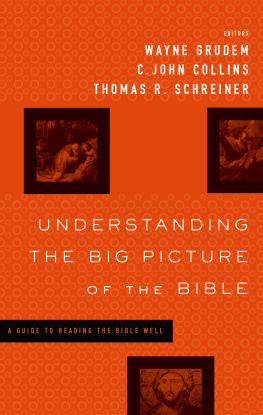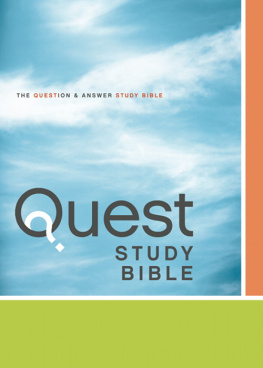Understanding the Big Picture of the Bible: A Guide to Reading the Bible Well
Copyright 2012 by Crossway
Published by Crossway
1300 Crescent Street
Wheaton, Illinois 60187
All rights reserved. No part of this publication may be reproduced, stored in a retrieval system, or transmitted in any form by any means, electronic, mechanical, photocopy, recording, or otherwise, without the prior permission of the publisher, except as provided for by USA copyright law.
The text and charts in this book are adapted from the ESV Study Bible .
Interior design and typesetting: Lakeside Design Plus
Cover design: Studio Gearbox
Cover image(s): Thinkstock
First printing 2012
Printed in the United States of America
Scripture quotations are from the ESV Bible ( The Holy Bible, English Standard Version ), copyright 2001 by Crossway. Used by permission. All rights reserved.
All emphases in Scripture quotations have been added.
| Trade Paperback ISBN: | 978-1-4335-3162-0 |
| PDF ISBN: | 978-1-4335-3163-7 |
| Mobipocket ISBN: | 978-1-4335-3164-4 |
| ePub ISBN: | 978-1-4335-3165-1 |
Library of Congress Cataloging-in-Publication Data
Understanding the big picture of the Bible : a guide to reading the Bible well / edited by Wayne Grudem, C. John Collins, and Thomas R. Schreiner.
p. cm.
ISBN 978-1-4335-3162-0 (tp)
1. BibleReading. I. Grudem, Wayne A. II. Collins, C. John, 1954 III. Schreiner, Thomas R.
BS600.3.U53 2012
220.6'1dc23 2011046837
Crossway is a publishing ministry of Good News Publishers.
VP 24 23 22 21 20 19 18 17 16 15 14 13 12
14 13 12 11 10 9 8 7 6 5 4 3 2 1
Contents
VERN S. POYTHRESS
C. JOHN COLLINS
GORDON WENHAM
DAVID HOWARD
DAVID REIMER
PAUL HOUSE
J. JULIUS SCOTT JR.
7 The Roman Empire and the Greco-Roman World
at the Time of the New Testament
DAVID CHAPMAN
JOHN DELHOUSAYE
THOMAS R. SCHREINER
DARRELL BOCK
THOMAS R. SCHREINER
DENNIS JOHNSON
1
C. John Collins
When it comes to describing the theology of the Old Testament, not everyone is convinced that there is a single theology represented in these diverse books. Many scholars have, however, tried to find a point of unity for all the books, often by proposing a single unifying theme, such as covenant, or the kingdom of God, or the Messiah, or God himself . These proposals do provide genuine insights, but they are often too oversimplified to do justice to the variety of materials in the Old Testament.
It will be more fruitful to understand the Old Testament as a whole in terms of an unfolding story, with a number of basic components: monotheism, creation and fall, election and covenant, covenant membership, and eschatology . This chapter will first explain these components, so that we can summarize the overarching story. Then we will consider briefly how the various parts of the Old Testament relate to this unfolding story, and consider how this provides a link to the New Testament authors stance toward the Old Testament. The goal is to articulate some of the beliefs that will enable careful readers to profit more fully from reading the Old Testament books themselves.
The Components of the Story
1. Monotheism . There is only one true God, who made heaven and earth and all mankind. He made a material world that he is happy with, and he made it a fit place for human beings to live, and love, and serve. Every human being needs to know and love this God, whose spotless moral purity, magnificent power and wisdom, steadfast faithfulness, and unceasing love are breathtakingly beautiful. This one God rules over all things, and he will vindicate his own goodness and justice (in his own time). In ruling, God has not limited himself to working within the natural properties of what he has made, for he can go (and has gone) beyond these properties to do mighty deeds both in creation and in caring for his people.
The Old Testament invites Israel not simply to acknowledge the existence of this one true God, but to commit themselves to him in exclusive loyalty and love, centering their lives on the inestimable privilege of knowing him (Deut. 6:49). The fundamental character of this God is explained in Exodus 34:67, which focuses on his steadfast love and mercy (a passage frequently echoed in the rest of the Old Testament). The Old Testament also affirms that God is righteous, that is, morally pure and perfect. Although this righteousness certainly results in Gods work of punishing evildoers and vindicating his own moral character, the term commonly emphasizes Gods reliability in keeping his promises (e.g., Pss. 71:2; 116:5).
The Old Testament does not explicitly describe God as a trinity. Rather, with its references to Gods Spirit (e.g., Gen. 1:2), its use of us/our for God (e.g., Gen. 1:26), and its indications or hints of a divine Messiah (e.g., Ps. 110:5; Isa. 9:6; see Ezek. 34:15, 23), it lays the groundwork for the fuller declaration of divine triunity that is found in the New Testament (Matt. 28:19; 1 Cor. 12:46; 2 Cor. 13:14).
2. Creation and fall . The one Creator God made the first human beings, Adam and Eve, with dignity and purpose; their calling was to live faithfully to God and to spread the blessings of Eden throughout the earth. Because Adam and Eve betrayed Gods purpose, all people since the fall are beset with sins and weaknesses that only Gods grace can redeem and heal.
3. Election and covenant . The one true God chose a people for himself and bound himself to them by his covenant (Ex. 19:46; Deut. 7:611). This covenant expressed Gods intention to save the people, and through them to bring light to the rest of the world, in order to restore all things to their proper functioning in the world God made. The land of Israel was to be a kind of reconstituted Eden, which would flourish as the peoples faithfulness flourished (or languish if the people were unfaithful). Gods covenants generally involve one person who represents the whole people (e.g., Adam, Noah, Abraham, David); the rest of the people experience the covenant by virtue of their inclusion in the community represented. The representative is required to embody the ideal of covenant faithfulness as a model for those on whose behalf he has acted.
4. Covenant membership . In his covenant, God offers his grace to his people: the forgiveness of their sins, the shaping of their lives in this world to reflect his own glory, and a part to play in bringing light to the Gentiles. Each member of Gods people is responsible to lay hold of this grace from the heart: to believe the promises (see Pauls use of Abraham and David as examples of faith in Rom. 4:125; see also Heb. 11:140), and then to grow in obeying the commands, and to keep on doing so all their lives long. Those who lay hold in this way are the faithful. These people, as distinct from the unfaithful among them, enjoy the full benefits of Gods love. Each Israelite is a member of a people, a corporate entity; the members have a mutual participation in the life of the people as a whole. Thus the spiritual and moral well-being of the whole affects the well-being of each of the members, and each member contributes to the others by his own spiritual and moral life. Thus each one shares the joys and sorrows of the others, and of the whole. Historical judgments upon the whole people often come because too many of the members are unfaithful; these judgments do not, however, bring the story of Gods people to an end but serve rather to purify and chasten that people (often by removing unbelieving members).





















